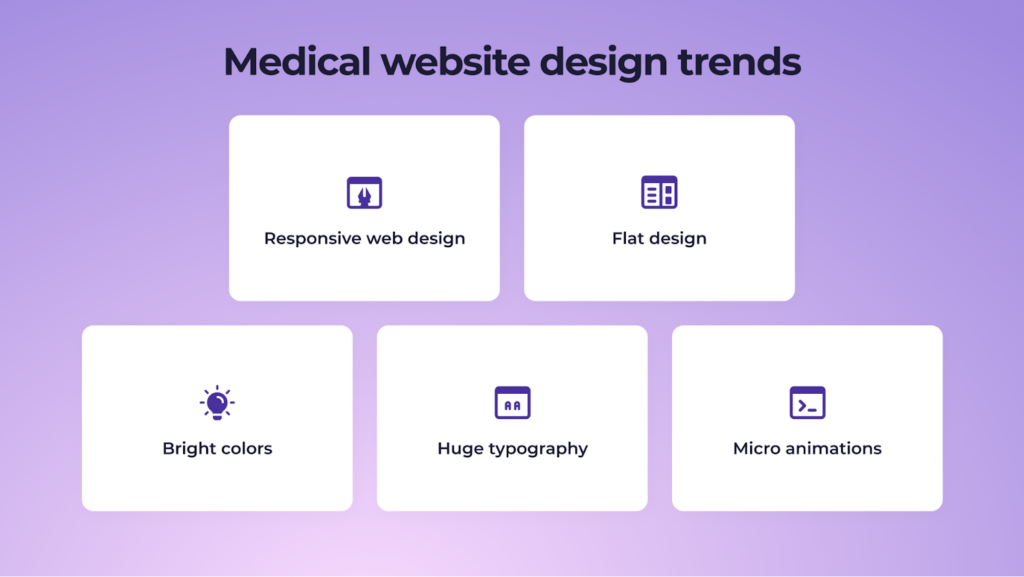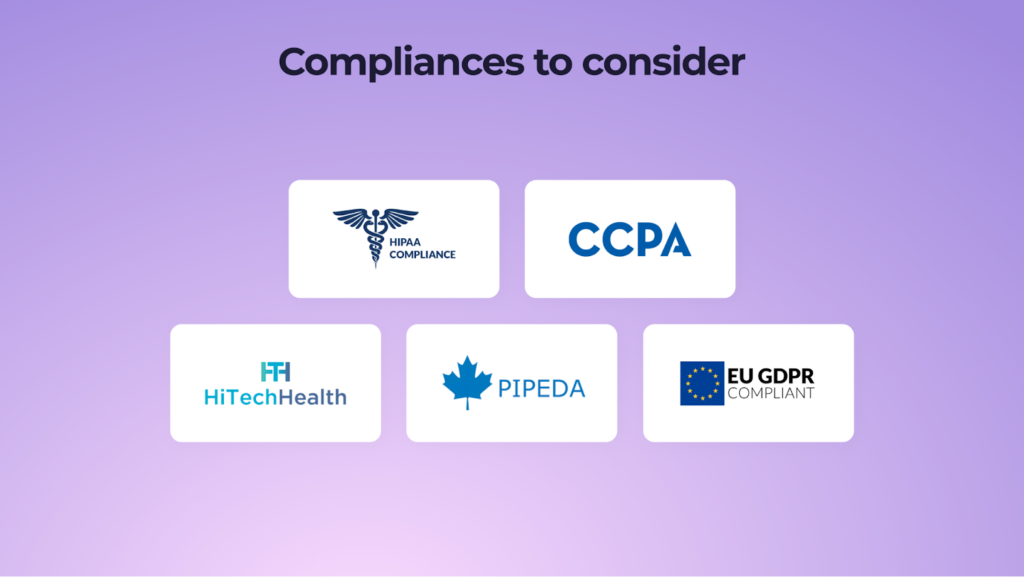Medical Website Development and Design: Things to Consider to Create a Jaw-dropping Platform

Healthcare services inevitably go online. Therefore, healthcare establishments are looking for a secure and convenient way to deliver medical care to patients. In this light, medical website development is a beneficial option to invest in. This post will guide you through the mainstream medical web design trends, features to implement, and essential regulatory requirements to consider.
Design Trends in Medical Website Development
Web design trends keep renovating by leaps and bounds, battling for users’ attention. From motion UI to AI-powered chatbots and low-code development, the list goes on and on. However, simplicity and understandability are the core principles of medical website UI/UX design. Thus, instead of focusing on animations and yelling banners, pay attention to user-friendliness.

Responsive web design
People love solutions on the go. Responsive websites mean that the content of your medical platform will squish and release consistently as the device size changes. This will allow patients to interact with your site over smartphones or tablets easily.
Flat design
The flat design remains one of the common approaches when designing digital healthcare solutions. It works with elements that are very streamlined with a focus on clear, minimalist, and laconic design. This way, you get a visually appealing medical platform while simplifying the user path to the point. In addition, it gives your message a better chance to be understood clearly and the right way, which is vital for this type of website since it concerns people’s health.
Bright colors
Clean and clutter-free web design doesn’t mean that your medical site lacks vivid colors. Quite the contrary, using a bright and deep palette is another trend to watch out for in medical website design creation. Moreover, it’s vital to select corporate colors patients will associate your brand with. For instance, light blue colors trigger trust, while green ones indicate serenity and hope.
Huge typography
Large font sizes are not typical for healthcare websites since they’re designed in a more conservative way. However, following this course will allow you to stand your brand out and upstage contestants. For example, you can add a considerable tagline text instead of considering a specialist photo as the central site image.
Motion
As I mentioned earlier, conciseness is the heart of medical practice web design development. As a part of this statement line, motion UI under healthcare site implies using micro animated elements (e.g., hover effects on a link, colorful animated icon) to spark patients’ interest without visual overloading.
Technical Side of Medical Platform Development
Now, let’s see what basic functionality should be integrated to create a patient-centric medical community. It’s highly recommended to start with implementing the MVP (must-have) features. This way, you’ll be able to test the idea validation without investing a tidy sum. Then, after identifying the weak spots of your medical startup (thanks to initial feedback), you can gradually scale up your website by incorporating more engaging and sophisticated functionality.
Core Features for Medical Platform
Basic information
This feature enables customers to find your clinic location and contact details. Additionally, if your entities are spread geographically, the visitors should be allowed to opt for preferred whereabouts. Moreover, adding a forceful and effective CTA button will significantly contribute to increased leads.
Primary services
Provide comprehensive information about medical care offered to assist patients in decision-making. If there is some specialized health delivery to focus on, ask your designers to highlight them to stick customers’ attention.
Medical stuff
Before applying to a particular doctor, people tend to look through multiple sources to retrieve more information. Hence, ensure adding information about healthcare providers, such as specialization, qualification level, experience, education, appointment slots, etc. The more details you include about specialists, the more trustworthy they become for clients. Skipping this point, you risk losing a tidbit of your potential customers.
Appointment scheduling
The essence of telemedicine website creation is to carry care assistance to patients worldwide at any given time. Hence, the users should be able to calendar the meeting with a specific physician by checking the availability of a required specialist and the appropriate date/time.
Search flow
A well-planned search engine simplifies the “website-patients” interaction and gets customers close to their goal – discovering the desired information. This, in turn, improves clients’ experience resulting in increased business revenue. You can also consider integrating filters that allow patients to quickly retrieve the services according to the parameters entered.
How to Build Medical Website And Succeed
Commonly, to deploy a web project, you need to determine the proper tech stack, including programming languages, frameworks, and 3rd party tools. However, medical app development also implies compliance with different regulatory standards, depending on location and other special conditions. I have outlined the widespread ones.

HIPAA. Applications operating in the US market that deal with managing, recording, and storing PHI data must follow HIPAA legislation. These regulations are made to ensure patients’ EHR protection and confidentiality. For example, to make your platform HIPAA compliant, SSL certificate, encryption, data backup and restore, and other preserves should be considered
PIPEDA. This document is similar to HIPAA with the difference that PIPEDA aims for another market. Healthcare digital solutions designed for the Canadian market must adhere to PIPEDA principles to ensure the privacy of patients’ data stored.
GDPR. It’s another country-specific document. Software solutions performing in the European market must comply with GDPR rules. What matters is that this law encompasses organizations that process clients’ information and the establishments that gather it.
HiTECH. HiTECH principles revolve more around the users’ data security and are justified in the USA. These laws broaden the HIPAA regulations by submitting more contributions to patients. For example, clients can access their medical info, such as lab test results, online or receive prompt notifications concerning unauthorized access to their medical profiles.
CCPA. This regulation guarantees individuals’ data protection in the United States and is akin to GDPR Act. This document is aimed at informing patients about the information gathered, generating reports on the compiled data per clients’ requests, clearing the data requested by patients, and far more.
Summing Up
Medical website development has never been more desirable than nowadays due to the post-pandemic reality and increased demand for quick and convenient medical care. Instead of waiting in long queues to schedule an appointment, people can easily choose the appropriate specialist and book a time slot in a couple of clicks. One of the things you need is to find an experienced web development company that will help you transform your idea into a powerful medical website.